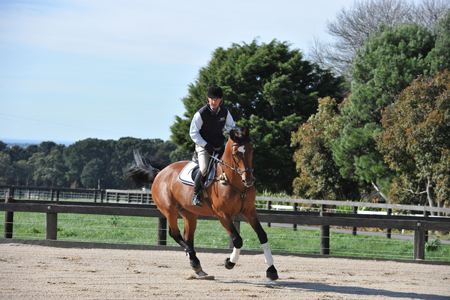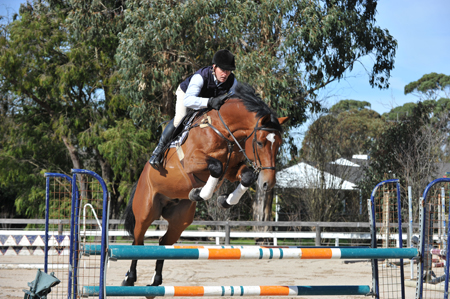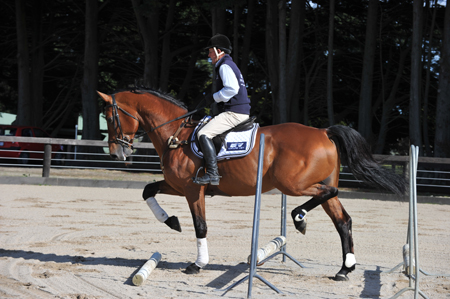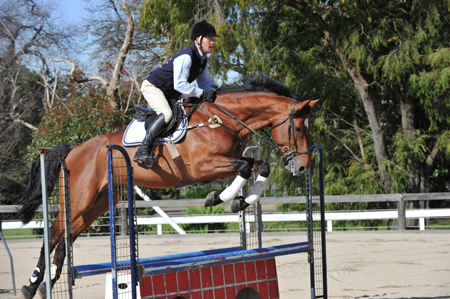One of the reasons I like working with Jamie Coman is that his whole operation is so quietly professional. The stables are neat, the horses look wonderful, the tack is clean, and the training, progressive and logical. It was even better to find that the equine subject for the day’s lesson was a really exciting young stallion, Noblewood Beretta. The bay is a big, big horse, and still has a long way to go in terms of physical maturity but he is a lovely mover with a brilliant technique over a jump.
Jamie was, not surprisingly, enthusiastic about the horse:
“Noblewood Park Beretta is a six-year-old, by Burggraaf, out of Noblewood Park Cantara, that’s Cantas line which is a line the Germans really like. He’s been with me for nearly one year. He has only four or five points in D grade, he’s just done double cleans. We’ve brought him along really slowly because he is a big horse and he needs time. He is extremely careful, and very trainable and rideable.”
Jamie had started the working session with the sort of dressage routine we’ve come to expect from good jumping rider/trainers…
You started him off with a few lateral exercises, is that how you normally work your horses?
“Once they accept your leg, I like those sort of exercises. With him being so big, and I am quite small, I really need to have him very rideable and adjustable – I do a lot of that with him, but I do a lot of those exercises with all my horses. I teach them to move off the leg – it might not be perfect, but it is as correct as I can make it.”
And the poles…
“They are mostly for me, to strengthen my upper body, to get me better, stronger through my core, to improve my connection. Through the poles, I stay tall with my eyes up, and then I get the elevation from the horse as well, he learns that he can be active and still stay contained. It is an exercise for him, but more so for me.”
With a big horse like him, it must be a challenge getting him muscle toned and fit…
“Those horses have big engines but there’s a mass of weight to carry and you have to have them super fit. I understand that well from having the Zazu horse that took me to the Sydney Games – even though he was a Thoroughbred, he was a massive horse. I like to have them super fit, if I can get them to a racetrack and just do slow gallop work – it’s fast for them – that is really good. It’s also good for them to go to a different environment, freshen up, and keep them happy with what you are doing with them, not just always schooling and drilling on the flat.”
You were saying when you started popping Beretta over the jumps that you liked to go off a very short turn to get him bouncy going into the jump…
“Very active, I don’t want to give him any reason to get long and flat in his canter. I want him always active from behind, starting to flow, and staying airy. The more active I can have the canter, the airier I can get the jump.”
Was he always that careful?
“Very. He has been a very careful horse all the way through, that’s why we’ve taken him slow. He is very watchful, he very rarely has a fence down – if he does it’s greenness or fatigue, he still gets a little tired, but he has always been extremely careful.”
You’ve ridden Burggraafs before?
“I rode a couple when I was in Europe at Henk Noren’s but nothing that looks as much like his sire as this one, he pretty much mirrors Burggraaf, he is very similar in the way he goes, but better in the mouth and more rideable. Burggraaf was quite a fierce going horse, but I haven’t ridden a horse like this for quite a while.”
He is extraordinarily flexible in his joints, is that natural or a result of the work?
“A bit of both. In my sit trot work, I want them nearly passaging. I’m not perfect at producing passage and I never will be, but I know what I want from my ride, and I want that real engagement and suspension. It does make them more supple through their joints. I use that elevated trotting exercise with the eventers I help – on the last day before the showjumping, because I need to get them slow and back in the air again. I get my eventing riders to do that exercise and it really gets them back and elevated again, because we can’t use our walking exercise any more, it is illegal. I need an exercise where I can still keep the rider and the horse slow and let them find out where their legs are again.”
With a horse like Beretta, you like to finish with a little circuit of jumps…
“I like to start with my flatting, then mix it with some jumping and if the jumping stays good, then finish on that. Otherwise, I’ll go back and finish on the flat again, making him sit, making him train again – so he is light, I want Sue or Hayley to be able to get on and ride him and know he is very light for them, he is not ever going to be heavy.”
How many days a week would you work a youngster like that?
“He gets five days a week, first day back after two days off, he’ll have just walking on the roads, then the next day he starts his program up to the Friday. Obviously if there is a show on the Saturday, we will take him. I am hoping to get him on the new Young Showjumping Horse squad that is starting, it’s like a talent squad, I’ll work towards getting him on that. This season he will just be jumping his D grades, 1.20 to 1.25. I don’t think I’ll be stepping him up to Futurities this year, I’d rather repeat the year just gone, his progress has been just great and we’ve got time enough, he’s a six-year-old, I don’t want him until he is a ten-year-old, he’s not going to be ready until then. My program is just to keep everything as accurate as I can, and to keep him happy to jump.”
He has bred mares, and it doesn’t seem to have affected his attitude…
“Obviously springtime comes and he is a little more full of himself, but you only have to growl at him a little, and he is very good again. He is very easy to handle… maybe that is because he actually ran with mares and he understands what mares are in season, but he knows when he works, it is work. When I take him to a competition, he is no problem at all. Obviously we have to have the green tag and someone there at the truck, but he is very, very good.”
That really big jump with the classy hind end, can you teach them that or are they born with it?
“I am sure a lot of it is natural, but a lot is your training too. A lot is creating a good canter, creating a canter that is active through the hocks. A lot is just making them feel light off the floor – and a lot of flatting can help. Just watching the European riders, their preparation is not all about jumping big fences, it is about the work on the flat, how rideable they have their horses. It is amazing their training. Look at Chris Chugg and Vivant, the better Chris got his dressage, the better the horse went. And the proof of the pudding is how rideable the horse is, even with another rider it is going on.”
Do you have the ride on this horse for long enough to have a crack at the big time with him?
“Yes, his owner, Robynne McTaggart, is a wonderful owner and she has given me the reins, you take your time with this horse. They just want to collect from him for the stud, but he lives here with me all the time, and that should be a nice long time.”
Australian showjumping has suffered of late with a series of high profile sales, hopefully Jamie and Beretta will be part of a revival and in the meantime, it is going to be fascinating to watch the new partnership develop.
PS. Congratulations to Jamie and Noblewood Park Beretta on their win at the 2011 Australian Showjumping Championships in the D Grade Point Score!
Story by Chris Hector & Photos by Roz Neave








